How To Order And Describe Sushi In Japanese (+ Read A Menu)
 Written byIchika Yamamoto
Written byIchika Yamamoto- Read time15 mins
- Comments1
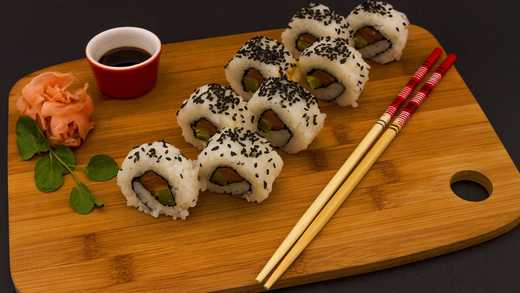
Sushi (寿司) is an iconic part of Japanese cuisine and culture.
If you’re visiting Japan, the local sushi is not to be missed. These days, sushi has spread worldwide and the concept and image of sushi might be different if you’ve only had sushi abroad.
The california roll, dragon roll, king crab roll, and spicy tuna roll that are popular in other parts of the world, don’t actually exist in Japan!
In Japan, sushi is simplistic and is mainly about enjoying the pure flavors of the ingredients themselves - usually fish - with perfectly cooked rice.
That being said, compared to sushi restaurants outside of Japan, there can be a lot of choice when it comes to the variety of fish, ingredients, and the style of preparation.
In this article, we’ll explore everything you’ll need to know in order to order sushi in Japanese.
Table of Contents:
- Parts of sushi
- ネタ
- シャリ
- 海苔
- わさび
- 醤油
- ガリ
- Main types of sushi
- にぎり
- ぐんかん
- 手巻き
- 巻き寿司
- 押し寿司
- ちらし寿司
- Other dishes with raw fish
- さしみ
- 盛り合わせ
- 鉄火丼
- 丼
- Places you can order sushi
- お寿司屋さん
- 回転寿司
- ファミリーレストラン
- Japanese phrases for ordering sushi
- Getting attention politely
- I’m unable to eat something
- Food allergies
- Asking for sushi items
- Wasabi
- Sushi recommendations/seasonal catch
- Paying for your sushi
Parts of sushi
The different parts of the sushi, such as the main ingredient, rice, seaweed, and condiments all have specific names.
It’s good to know this terminology in Japanese so that you can be comfortable asking questions or making requests at a sushi restaurant.
Neta - ネタ - main ingredient (often raw seafood)
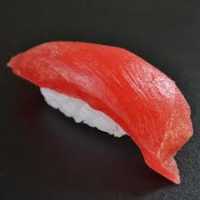
This is the main part of the sushi, which is usually seafood, but can also be egg or certain vegetables.
In a nigiri sushi, the neta is sliced and placed on top. In other types of sushi, it can go inside rolls or it can be wrapped in seaweed.
In traditional sushi restaurants these ingredients are often displayed in a temperature controlled glass case.
Shari - シャリ - vinegared rice
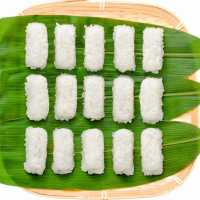
This one’s obvious.
Another important component of sushi, is the rice.
In sushi, the rice is special because it has been flavored with a sweetened rice vinegar.
Nori - 海苔 - seaweed
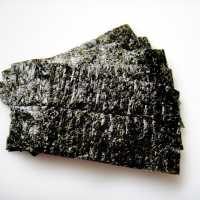
This is a dried sheet of seaweed that can be used to hold the rice and ingredients.
It is an important part of gunkan, makizushi, and temaki _style _sushi.
The seaweed is usually roasted beforehand so that it has a crisp texture.
Wasabi - わさび - Japanese horseradish
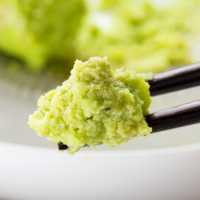
This is a unique element in sushi because it adds spice. Most “wasabi” that is served is actually regular horseradish.
For wasabi to grow, the water must be clean and at a certain temperature. If you want to taste the difference, you can typically find real wasabi if you go to high-end sushi restaurants.
Shoyu - 醤油 - soy sauce
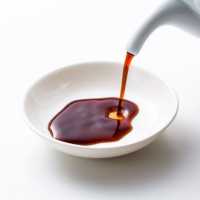
This is how salt flavor is added to sushi.
Traditionally, sushi should be dipped with the topping facing the soy sauce so that the rice doesn’t get soaked with it.
Gari - ガリ
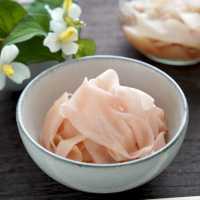
This is a pickled ginger that is eaten on the side.
The strong flavor of the ginger can help to cleanse your palate before the next piece of sushi.
Main types of sushi
Sushi can come in many different forms, and the form depends on the ingredient and the type of restaurant. Some types are more suited for homestyle cooking.
Nigiri - にぎり
The name nigiri comes from the verb nigiru, which means to grab or hold.
This sushi is made by gently forming the rice into an oval shape. A piece of sliced seafood or sometimes egg is placed on top.
This is usually only found in restaurants.
The cutting of the seafood and the forming of the rice takes years of practice!
Common toppings in nigiri sushi:
Served raw:
| Japanese | Romaji | English |
|---|---|---|
| まぐろ | Maguro | tuna |
| 赤身 | Akami | low fat tuna |
| 中とろ | Chuutoro | medium fatty tuna |
| 大とろ | Ootoro | extra fatty tuna |
| 光物 | Hikarimono | Seasonal shiny skinned fish (often cured in vinegar) |
| こはだ | Kohada | gizzard shad |
| あじ | Aji | horse mackerel |
| さば | Saba | pacific mackerel |
| サーモン | Saamon | salmon |
| ひらめ | Hirame | flounder |
| いか | Ika | squid |
| ほたて | Hotate | scallop |
| かんぱち | Kanpachi | greater amberjack fish |
Served cooked:
| Japanese | Romaji | English |
|---|---|---|
| えび | Ebi | shrimp (lightly poached) |
| 穴子 | Anago | saltwater eel (cooked with sauce) |
| たまご | Tamago | sweet egg omelet |
| たこ | Tako | Octopus (lightly poached) |
| いなり寿司 | Inarizushi | rice wrapped in thin seasoned fried tofu |
Gunkan - ぐんかん
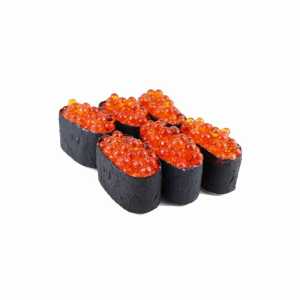
The name gunkan means warship. This type of sushi is meant to create a vessel for the ingredient. The rice is shaped by hand like a nigiri, but a strip of seaweed is placed around the rice to create a border.
They are usually topped by ingredients that would fall off without the seaweed.
Common ingredients in gunkan sushi also applicable with temaki:
| Japanese | Romaji | English |
|---|---|---|
| ねぎとろ | Negitoro | mashed fatty tuna with green onions |
| うに | Uni | sea urchin |
| いくら | Ikura | salmon roe |
Temaki - 手巻き
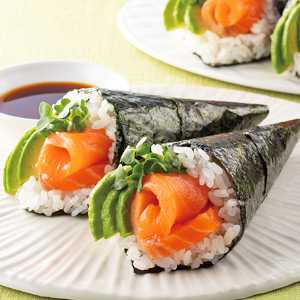
Temaki literally translates to hand rolled. This type of sushi is where a square piece of seaweed is rolled into a cone with vinegared rice and ingredients inside.
It can be found in sushi restaurants and it is also popular for making at home. Most gunkan sushi can also be requested in the form of temaki.
The ingredients are also similar to gunkan as the seaweed can help hold the ingredients together.
Makizushi - 巻き寿司
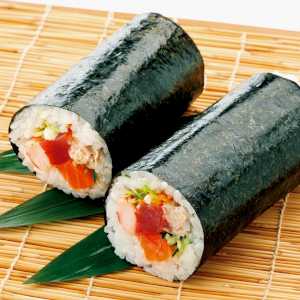
This is a traditional rolled sushi where there is a layer of seaweed and rice on the outside and then ingredients in the middle.
A bamboo mat is usually used to form the shape of the roll. In Japan, most rolled sushi has seaweed on the outside.
This is a type of sushi that can be found at professional sushi restaurants and it’s also popular for home cooks.
Types of makizushi
| Japanese | Romaji | English |
|---|---|---|
| 太巻き | Futomaki | thick Sushi roll |
| かっぱ巻き | Kappamaki | cucumber roll |
| 鉄火巻き | Tekkamaki | tuna roll |
| 納豆巻き | Nattomaki | fermented soybean roll |
| 寛平巻き | Kanpyo maki | dried calabash squash roll |
Oshizushi - 押し寿司
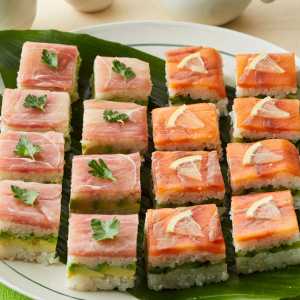
Oshizushi comes from the word osu, meaning to press. This sushi is pressed into a wooden mold with a layer of the main ingredient and a layer of vinegared rice.
The pressed sushi is then cut into rectangular pieces.
This was one of the first ways that sushi was made and it’s common to use fish that has been preserved in vinegar.
Chirashizushi - ちらし寿司
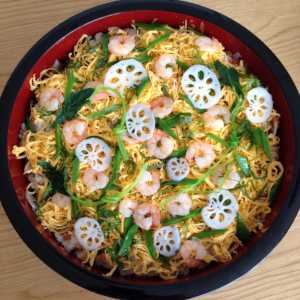
The name for chirashizushi comes from the word chirasu, which means to scatter.
This sushi is usually served in a large wooden bowl where there is a layer of rice and multiple types of sushi toppings scattered on top. It’s a large portion that is meant to be shared.
It doesn’t require much skill in terms of cutting or fileting the ingredients, so it is also commonly made at home during celebrations.
This is not a sushi that you’ll normally find in a sushi restaurant, but smaller portions may be served during lunch time in the form of a donburi or bowl.
Other types of dishes involving raw fish
A common misconception about sushi is that anything with raw fish or seafood is sushi.
However, it’s important to know that the following dishes can be similar to sushi but it is something different.
If you’re looking to order these dishes at a sushi restaurant they may not serve them.
Sashimi - さしみ
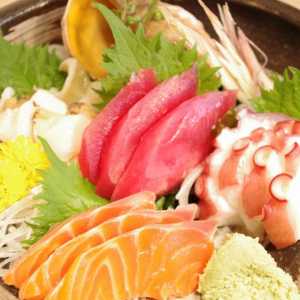
Sashimi is not sushi, but simply raw sliced seafood or meat. It can be found in some sushi restaurants but it’s more common as an appetizer in Japanese-style bars.
The raw seafood or meat can be dipped in soy sauce and some wasabi.
Moriawase - 盛り合わせ
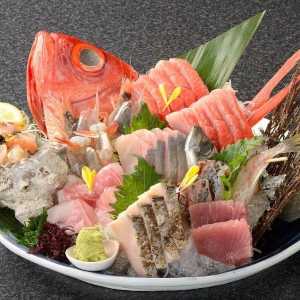
Sashimi is usually found as a* moriawase*, which means that it comes as a set of many types of sashimi.
These plates are meant to be shared at the table, and it’s a common appetizer plate that can be found in Japanese-style restaurants.
Tekkadon - 鉄火丼
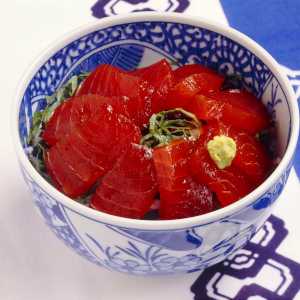
This is a rice bowl that contains raw tuna on top of rice. The tuna is meant to be dipped in soy sauce and enjoyed with the rice.
It’s more common to find this in Japanese-style restaurants, instead of a sushi restaurant.
(__) don - (__) 丼
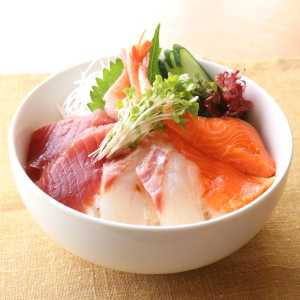
If you’re looking for sashimi on top of rice, look out for the word don.
This indicates that the dish is a rice bowl. Various ingredients like salmon roe, salmon, or sea urchin, can be placed in the blank to create different types of rice bowls.
These dishes are common in fish markets or places with fresh seafood.
Places you can order sushi
Osushiya san - お寿司屋さん - sushi restaurant
Sushi restaurants are called osushiyasan.
These places typically only serve nigiri, gunkan, and some makizushi. There are different price levels depending on the quality you are looking for.
It can primarily be categorized into two types.
Standard sushi restaurant
A standard sushi place will usually have the prices of their menu items out in the open.
It is more affordable and you can either order based on what you want or as a set menu.
High-end sushi restaurant
A high-end restaurant will often have less than 20 seats at a counter.
These places need to be booked in advance and they take their craft of making sushi very seriously. The menu is usually omakase, which means you leave it up to the chef. The chef will prepare a menu that features the freshest ingredients and the best catch of the day.
The other important thing to note is that the price will not be displayed in these restaurants.
You can ask in advance but you have to make sure you have enough money before going.
回転寿司 - Kaitenzushi - conveyor belt sushi
This can be a fun and affordable sushi experience!
The sushi will already be on plates going around the room on a conveyor belt.
You simply have to pick and choose the plate that you want. There are usually the sushi chefs in the middle who can also make you custom plates if you want something specific.
At the end of your meal, someone will come count the number of plates and calculate the price.
ファミリーレストラン和食レストラン - Famirii resutoran / washoku resutoran - Family restaurants / Japanese-style restaurants
Sushi can also be found in casual eateries such as family restaurants and Japanese-style restaurants.
These places try to have a variety of food to cater to all tastes. You can often find some kind of sushi plate or set menu at these places.
Some will also include other dishes such as udon noodles or tempura to go with your sushi.
Useful phrases at a sushi restaurant
Now that we’ve gone through the different types of sushi, ingredients, and restaurants, here is how to put them in use.
Below are some useful phrases to ask for things, order, and show politeness.
Getting attention politely

すみません
Sumimasen.
This is a handy phrase that you can use to catch the waiter or sushi chef’s attention.
Use this phrase before requesting or asking for things to show politeness.

すみません!まぐろをください。
Sumimasen! Maguro wo kudasai.
I’m unable to eat something

_ が食べられません。
_ ga taberaremasen.
If you have any foods that you can’t eat you can indicate it here so the chef knows.
For example, if you are a vegetarian you can say:

肉と魚が食べられません。
Niku to sakana ga taberaremasen.
If you don’t feel comfortable eating raw fish, you can say:

生魚が食べられません。
Namazakana ga taberaremasen.
Food allergies

_ のアレルギーがあります。
_ no arerugii ga arimasu.
If you have allergies it’s recommended to look up the words in Japanese in advance for the specific names of the food.
If you make a reservation for a high-end restaurant you might want to notify them early.

たこのアレルギーがあります。
Tako no arerugii ga arimasu.
Asking for sushi items

_をください。
_ wo kudasai
For asking things and to order sushi, use this phrase.
It’s common in sushi restaurants to order nigiri sushi directly from the chef. This is also especially useful at conveyor belt sushi restaurants.
If your favorite nigiri sushi is not coming around on the belt, you can call out to the chef.

大とろをください。
Ootoro wo kudasai.
Tea is typically free at sushi restaurants, and you are also able to make your own tea at the counter of conveyor belt sushi places.
You can request tea by saying the following:

お茶をください。
Ocha wo kudasai.
Wasabi

さびぬきでお願いします。
Sabi nuki de onegai shimasu.
Wasabi can be a strong spice for some people.
This is a way to request sushi without wasabi. Most _nigiri _sushi comes with the wasabi in between the rice and main ingredient.
Sushi recommendations

今旬の魚は何ですか?
Ima shun no sakana wa nandesuka?
If you’d like to taste a fish or seafood that’s in season, you can try this phrase.
This way you can try the fish that are only available during certain times.

オススメはありますか?
Osusume wa arimasu ka?
If you’re confused about what to order, ask the chef or waiter for a recommendation. Many sushi restaurants offer a setting where you are sitting directly in front of the sushi chef.
Paying for your sushi

お会計お願いします。
Okaikei onegai shimasu.
At the end of your meal you can ask for the bill.
If you’re at a conveyor belt sushi restaurant the waiter will come to count your plates. Plates at these restaurants are color-coded based on price.
They will add up the total for you this way.

ごちそうさまでした。
Gochisousama deshita
When you leave the restaurant it’s polite to say this phrase.
You can express your gratitude and appreciation for the food to the chef and restaurant.
Conclusion
There you have it!
Next time you go out for some sushi, you’ll be better equipped to read the menu and order your meal (in Japanese).
If you’re looking for even more detailed lessons that cover sushi and Japanese food, Rocket Japanese has some excellent advanced audio lessons that cover it in more detail.
Did I miss anything?
Let me know in the comment section.
 Grab the link to this article
Grab the link to this article